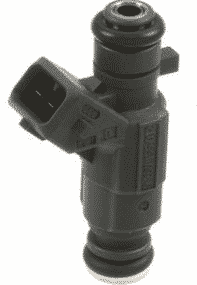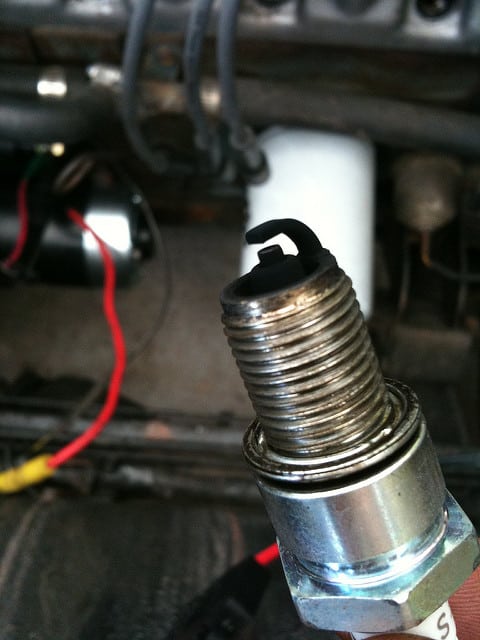
Spark plug troubles got your vehicle down?
Hey, Mike here.
This guide on how and when to replace the spark plugs in your car is very timely. I recently concluded a near-painful experience with my wife’s car. It took me and my mechanic seven weeks to bring the car back to life. It all started with a simple misfire followed by the dreaded check engine light. After that, the car simply refused to start with no additional symptoms.
The first mechanic was a dud. He was able to determine the cause of the check engine light using a simple OBD2 vehicle scanner. The code was P0261 Cylinder 1 Injector Circuit Low, which basically meant a problem with fuel injector #1. But the mechanic told me the injectors were fine. He concluded it was an ECU problem, which was frankly mind-boggling to say the least.
At the back of my mind, a new ECU will cost north of $600 or $700. I decided to get a second opinion by seeking the services of a different mechanic. However, the weather took a turn for the worst and it took us weeks of waiting to finally complete the repair.
Related: Denso Platinum Spark Plug Review

As it turned out, the fuel injectors were dirty. After cleaning the injectors, the mechanic noticed a weak spark. It took me days to find an OEM spec ignition coil to replace the old unit. My mechanic also told me to buy a new set of OEM Iridium spark plugs, which costs 5x more than ordinary spark plugs.
After everything was bolted into place, the car started without any sign of hesitation. Finally after seven weeks of waiting, bad weather, and conflicting schedules, the car was running like nothing happened! The entire process also refreshed my knowledge on the intricate wonders of a modern engine system. A simple problem such as a weak spark or a faulty spark plug is enough to completely throw off the calibration of the intake, fuel, combustion, and exhaust system in your vehicle.
How often do you need to change the spark plugs?
It depends. Check the owner’s manual or the service manual of your car. Car manufacturers will specify different intervals depending on the make, model, and engine type. The general rule is to pull out and inspect the spark plugs every 30,000 or so miles as you change the oil.
Vehicles equipped with extended-life spark plugs (like my wife’s car that will only run on expensive Iridium spark plugs) can still maintain a precise gap and efficient spark for 100,000 miles. However, this doesn’t mean you should wait for 100,000 miles before inspecting, cleaning, or replacing the spark plugs.
Bear in mind that extended-life spark plugs will be moderately worn out by the 80,000-mile mark. By this time, the gap between the central and side electrode will be wide enough to drastically affect engine performance, acceleration, idling speed, and fuel economy. Making matters worse is the possibility of the spark plugs seizing in the cylinder head after thousands of miles of heat and wear.
If you want an “environmental friendly” spark plug, take a look at the NGK G-Power
Remember when it comes to replacing the spark plugs in your car, it is best to do it sooner instead of waiting later. I always recommend changing the spark plugs at least every 6 months or 1 year for everyday cars. Vehicles equipped with extended-life spark plugs should be inspected and cleaned after changing the oil.

How will I know if my car needs new spark plugs?
At the first sign of engine misfire or combustion problems, the basic rule is to pull out the spark plugs. This will also give you an idea on the general condition of the motor by inspecting the spark plugs. If the tips of the plugs are wet with oil or water, better have the engine checked immediately. This could be an indication of an oil or water leak seeping inside the combustion chamber.
Here are the main signs that might indicate your vehicle needs a new set of spark plugs:
- Rough idling. Did you notice the car idling roughly especially if the HVAC is ON? This problem can also be caused by a faulty fuel pump or a dirty throttle body, but the basic rule is to check and replace the spark plugs. If you’re not sure, refer to your favorite mechanic.
- Engine misfire. Weak sparks or fouled-up spark plugs caused by deposit build-up will cause one or more of the cylinders to misfire. If the spark plugs are relatively new, a simple cleaning job might fix the problem. It is also a good idea to change the oil and replace the air filter to reduce the amount of carbon build up inside the motor.
- Sluggish acceleration. Does the car feel slower when you step on the gas? Again, this problem can be caused by other factors. Simply checking the condition or replacing the spark plugs will correct this minor problem.
- Surging and Hesitation. Worn out spark plugs will cause the engine to suddenly surge or hesitate as you step on the gas. This is a dangerous problem that should be corrected immediately. Hesitation will also result in poor acceleration and diminished performance over inclined roads.
- Difficulty starting the engine. I know this by experience. Dirty, worn out, or bad spark plugs will make it difficult to start the car, especially in a cold and frosty morning. In the absence of major engine and electrical problems, hard starting can be remedied by upgrading to a new set of spark plugs.
- Poor fuel economy. The engine will need to work harder and consumer more fuel to propel the vehicle. Weak or faulty spark plugs will drastically affect the fuel economy in your ride, even in a small and relatively humble mini compact car. In most cases, the spark plug gap will only need to be adjusted to the correct specification to rectify the problem. But in the case of old or worn out spark plugs, replacing the plugs is the only option.
Is your car working fine but you forgot the last time you replaced the spark plugs? It is better to err on the side of caution and replace the spark plugs immediately before the first sign of an engine problem. Prolonged engine operation running with faulty spark plugs will only cause more damage.

How long do spark plugs last?
Standard copper plugs have a useful life of 10,000 to 20,000 miles (roughly 16,000 to 32,000 kilometers). Platinum spark plugs can last for up to 60,000 miles or 96,000 kilometers. The more expensive Iridium variety can go for more than 120,000 miles or 193,000 kilometers before needing replacement. Again, keep in mind that the life of the spark plugs will also depend on the severity of usage and the general condition of the engine.
What spark plugs should I buy?
Use the same plugs that your car came with (OEM) or check your owner’s manual.
A lot of car owners will simply go to the shop and ask for a brand new pair of spark plugs for this or that type of vehicle, which is wrong. The best thing to do is to bring along a sample of the actual spark plug inside your engine provided that the spark plugs weren’t replaced with aftermarket plugs.
Again, the easiest way to figure this out is to consult the owner’s manual or service manual. Spark plug types are classified according to a model number that consists of a bewildering array of alphanumeric figures. As an example, my wife’s car required LZFR5BI-11 spark plugs from NGK, which were Iridium plugs. It is technically possible to use a different model of spark plugs as long as the plugs are of the same size as the original, but this may lead to significant engine problems and loss of performance in the long run. I even noticed engine pinging on my older car when I tried to insert the wrong type of spark plugs.
When buying new spark plugs, always insist on the OEM plugs unless your vehicle is modified for racing applications. Using the right set of spark plugs for your vehicle is safe insurance against catastrophic engine failure.
If your car came equipped with ordinary copper plugs from the factory, the engine will run smoother and perform better if you use the same type of plugs. There is no need to shell out more money for a more expensive set of platinum or iridium spark plugs especially if the manufacturer doesn’t require the use of such plugs. Don’t believe the hype or false claims of improved performance, faster acceleration, and better fuel economy by simply using a different set of special spark plugs.
Pro TipIf you want to read more about some spark plugs that we like, check out this guide: https://scanneranswers.com/best-spark-plugs-for-horsepower-performance-fuel-mileage/
How do I replace the spark plugs in my car?
Jessicann did a great video on this topic. Check out her Youtube channel for more DIY vehicle videos!
All you need is a simple set of hand tools and a new set of spark plugs.
- Step 1: Park the car in a safe and level area. It is best to work with a cool motor. If the engine is hot, pop the hood open and let it air out to cool the engine.
- Step 2: Depending on the make and model of your vehicle, you may need to remove the engine cover or other components on top of the engine to gain easy access to the ignition coils or spark plug wires (high-tension wires). On some older cars, this means removing the circular air filter or intake hose. Remove the parts and set them aside.
- Step 3: On vehicles equipped with spark plug wires, simply squeeze the top of the wires and pull out gently. If your vehicle is equipped with individual ignition coils, use a ratchet and socket set to remove the bolt/bolts on top of the ignition coils. Simply pull out the coils after removing the bolts.
- Step 4: Grab your socket set and remove the spark plugs by turning counterclockwise. Pull out each spark plug and set them aside.
- Step 5: Check the spark plug gap on the new spark plugs before installing. Use a feeler gauge to check the gap and adjust accordingly. Refer to the owner’s manual to determine the correct gap for your vehicle.
- Step 6: Install each spark plug in the corresponding hole and tighten sufficiently. It is better to use a torque wrench at this point especially if your vehicle is equipped with aluminum engine components. The trick is to tighten the spark plugs just enough to seal the holes. Remember that spark plugs are equipped with seals to prevent leakage.
- Step 7: Simply install the wires or the ignition coils, tighten everything up, and you’re good to go! Start the engine and check the idling. Take the car for a short test drive.
Conclusion
We hope this guide has been helpful in letting you know when to replace the spark plugs in your vehicle next time. If you got any questions, leave us a comment!
-Mike